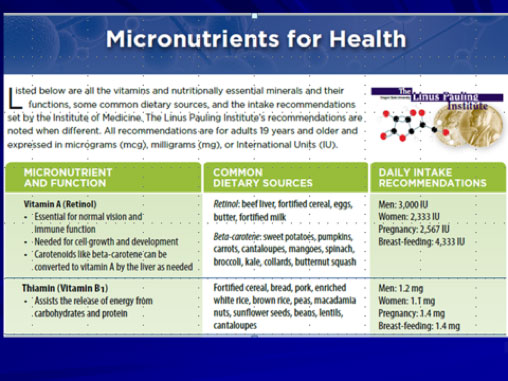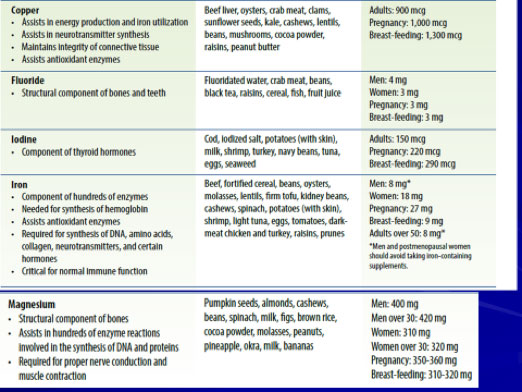Micronutrients
What are micronutrients?
Micronutrients, as opposed to macronutrients (protein, carbohydrates and fat), consist of 13 vitamins and 14 minerals. They have to be obtained in small amounts from the diet (except Vitamin D).
Micronutrients don’t provide calories/energy like macronutrients, but help convert food into energy, and have hundreds of other biological functions in the body. They are cofactors (coenzymes) of thousands of enzymes; are essential in hormone production; and are structural elements of bone, teeth, proteins, DNA, and other biological macromolecules. They are also powerful antioxidants.
When their intake is inadequate, vitamin and mineral deficiency disorders are the consequences that may affect all aspects of metabolism. The micronutrients are listed below.
Water-Soluble (9)
B-Vitamins:
Thiamin (B1)
Riboflavin (B2)
Niacin (B3)
Pantothenic Acid (B5)
Vitamin B6 (pyridoxal)
Biotin (B7)
Folic acid (B9, folate)
Vitamin B12 (cyanocobalamin)
Vitamin C (ascorbic acid)
Fat-Soluble (4)
Vitamin A (retinol)
Vitamin D (calciferol)
Vitamin E (alpha-tocopherol)
Vitamin K (phylloquinone)
14 Nutritionally Essential Minerals
Macro-Minerals (5)
Calcium
Magnesium
Phosphorus
Potassium
Sodium (Chloride)
Trace Minerals (9)
Chromium
Copper
Fluoride
Iodine
Iron
Manganese
Molybdenum
Selenium
Zinc
No single food contains all the micronutrients required for optimal metabolism, so a balanced and varied diet is necessary to ensure an adequate intake.
There is a difference between micronutrient deficiency and inadequacy. For example, in micronutrient deficiencies, a low intake results in deficiency disease and overt symptoms. This is rare, but not absent, and common for iron, Vitamin A, zinc, and iodine.
In micronutrient inadequacies, the intake is sufficient to prevent deficiency disease but below the recommended dietary allowance (RDA). Micronutrient inadequacies are common in developing countries.
Just because someone doesn’t have any symptoms doesn’t mean they don’t have a micronutrient inadequacy that may prevent achieving optimal health. If a tire was low on your car but producing no adverse effect on your driving (inadequacy), would you wait until the tire goes flat (deficiency) before you ask the question, “Why is my tire low?”
Dietary guidelines for Americans are presented in Figure 1.














